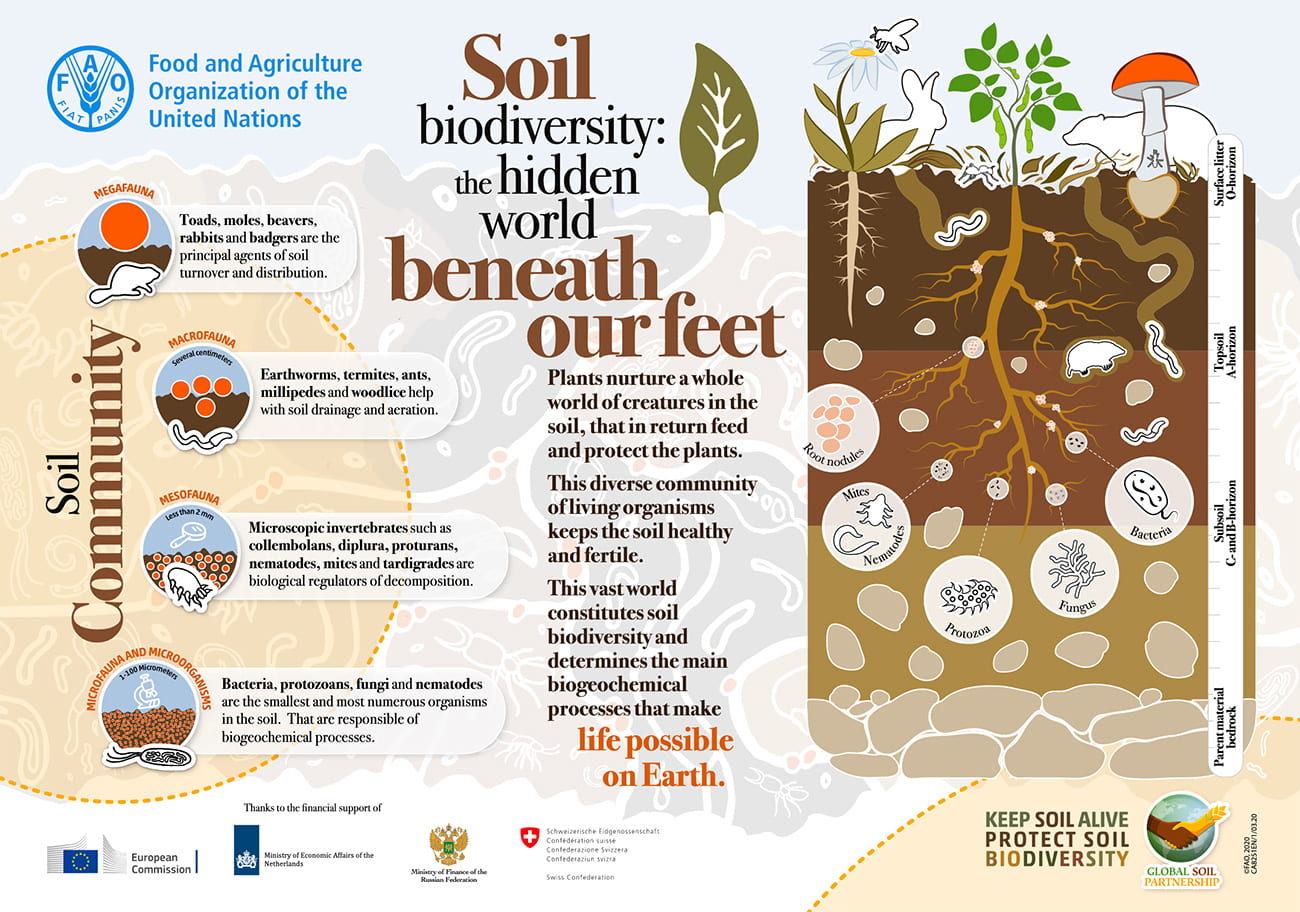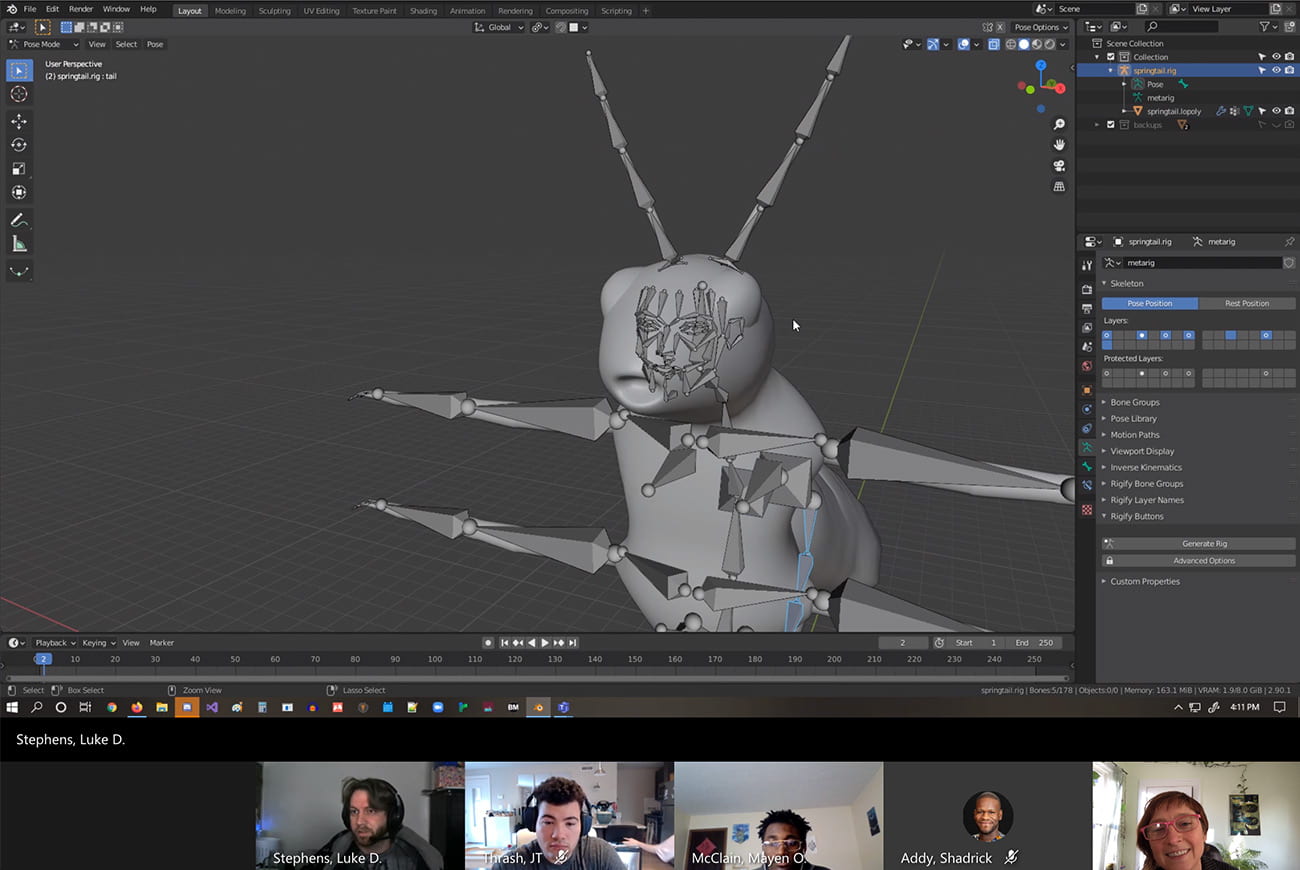 Our project is featured in Interalia Magazine, check it out!
Our project is featured in Interalia Magazine, check it out!
News
Springtails dance for World Soil Day
Today is #worldsoilday and Springtails are being celebrated as they are important to building healthy soil.
I first learned about these tiny arthropods when I saw them in my worm bin. They are not pests; they are part of the community in a healthy worm composting system and in soils around the world. Normally they are very difficult to see, but here they are magnified with a macro lens, so they become more visible. These superheros can walk on water and on the worm tea fertilizer they helped create. Don’t you wish you could experience what they do? This is what we are working on in our Belonging to Soil virtual reality project.
To see professional images of springtails, including a good variety of colors and species, check out this video featuring springtail photographer Andy Murray. Produced for World Soil Day by the Food and Agriculture Organization of the United Nations .
Amazing to learn that springtails colonized land 400 million years ago and worked alongside bacteria and fungi to create the first soils!
Eating Waterbears
Though they are invisible to our human eye, waterbears, (tardigrades) are plentiful in wet zones in and around soil. They eat moss and are sometimes called “moss piglets”. I read in Biology of the Springtails, that some varieties of springtails eat them, so this activity is part of the virtual reality experience for you, as a springtail. You can only eat them when they emerge above the water, and you need to get your mouth near them. Josh Rodenberg, the sound artist who is making the music, is currently working on making a satisfying popping sound for eating waterbears.
The pink blobs are springtail excrement, (AKA poop), which happens when you squat and squeeze your fists, but only after you have eaten. In the video, pooping is happening at the same time as eating waterbears, since the action is similar. Defining these as different is something we are still working on at the coding level.
Like most poop, springtail poop is food for other things – microorganisms and plants – so this is one of the superpowers of springtails that keeps the ecosystem healthy. More on this in a future post.
* Hopkin, Stephen P. Biology of the Springtails: (Insecta: Collembola). United Kingdom: OUP Oxford, 1997.
Underground environment
Mayen McClain has been working on the underground scene; including plant roots, soil, minerals, bacteria, and mycelia. To indicate that this scene is close to the top of the soil, there are porous holes that let light in through the top of the soil chamber. These photos are taken from inside the Oculus VR headset.


This is the view from outside of the world, the black lines at the top are the springtail antennae.
Video captured from inside VR. Shows the animated root growing, plus moving around in the chamber, over rocks, streptomyces bacteria (the blue parts), and among the roots. The tunnels that are blocked off now, will eventually lead to additional scenes and environments.
Springtail avatar
Luke Stephens modeled the springtail body in the 3D software Blender.

The virtual skeleton that activates the movements of the avatar is placed inside the springtail model. The Humanoid Controller for VR had to be adjusted to fit into the springtail body, but the extra set of legs really caused the whole body to malfunction. So Luke had to redesign the character.  The new character also has hands, which is not realistic to springtail insects, but since it is a part of the Humanoid Controller they were included.
The new character also has hands, which is not realistic to springtail insects, but since it is a part of the Humanoid Controller they were included. 
Though compromises had to be made to get the avatar to work in VR, this is expected. The very idea that humans can understand what it is like to operate the body of another is fraught with challenges. There are always approximations and best guesses.
Springtail avatar is jumping
Making progress on the avatar and the jumping interaction!
Luke Stephens has made a springtail avatar with a giant abdomen with a spring mechanism (furcula) that animates during jumping.

JT Thrash has coded the interaction of jumping, seen in the video. Next step is to test it out in a VR headset to find out how dizzy it makes us.
World Soil Day
Today we celebrate World Soil Day!
And we share this video from the United Nations Food and Agriculture Organization, that explains why this ecosystem is so important and deserves a day of celebration.
“World Soil Day 2020 (#WorldSoilDay) and its campaign “Keep soil alive, Protect soil biodiversity” aims to raise awareness of the importance of maintaining healthy ecosystems and human well-being by addressing the growing challenges in soil management, fighting soil biodiversity loss, increasing soil awareness and encouraging governments, organizations, communities and individuals around the world to commit to proactively improving soil health”

We are finding great inspiration in knowing more about the biodiversity underground. Springtails are in the collembolan family, which are in the mesofauna category of the soil community. This is based on their size (less than 2mm). Very hard to see and appreciate with the naked eye, which is another reason we are working to highlight them in our VR experience, Belonging to Soil.
Inhabiting a springtail
We want to be able to experience an approximation of what it is like to be a springtail, so we are experimenting with ways to use VR to become one. In virtual reality, avatars are designed to operate human shaped bodies, so we are working to “mis-use” the tools or extend it so it can get us beyond the human.
Luke Stephens is developing a springtail body with a human “skeleton” (animation rig). Then JT Thrash and Shadrick Addy are mapping this rig to the Humanoid Controller SDK (Software Development Kit) in Unity.

Springtail avatar modeled in Blender
The challenges we are encountering are many, including the need to adjust to the differences between the springtail body and the human body. For instance, we lack the antennae, a jumping apparatus (furcula), and extra legs. How do we control all of those extra appendages? Also, should we humans crawl on our hands and feet to conform to the springtail stance? We decided to have the springtail avatar take a human stance, but still include the antennae, furcula, and extra arms/legs.

Shadrick preparing to test the springtail body in VR
We will experiment with ways to control these appendages with our body gestures. There was one appendage we did not include on the body, the collophore; a two-part tube that inflates from their abdomen for cleaning and for sticking to surfaces when landing. It looks very challenging to operate a springtail body. Watch the collophore in action in the video below, from the fabulous show Life in the Undergrowth, a BBC series with David Attenborough.
Introduction video
Our team created a video to describe our Belonging to Soil project in process. We discuss our inspirations, the story, the tools, environment, characters, and interaction design.
We created it as part of Shadrick Addy’s larger presentation on his work and history, presented at a Hopkins Hybrid Arts Lab event in the Department of Design. It is very inspiring, check it out: Making Lemonade: My Design Life.
